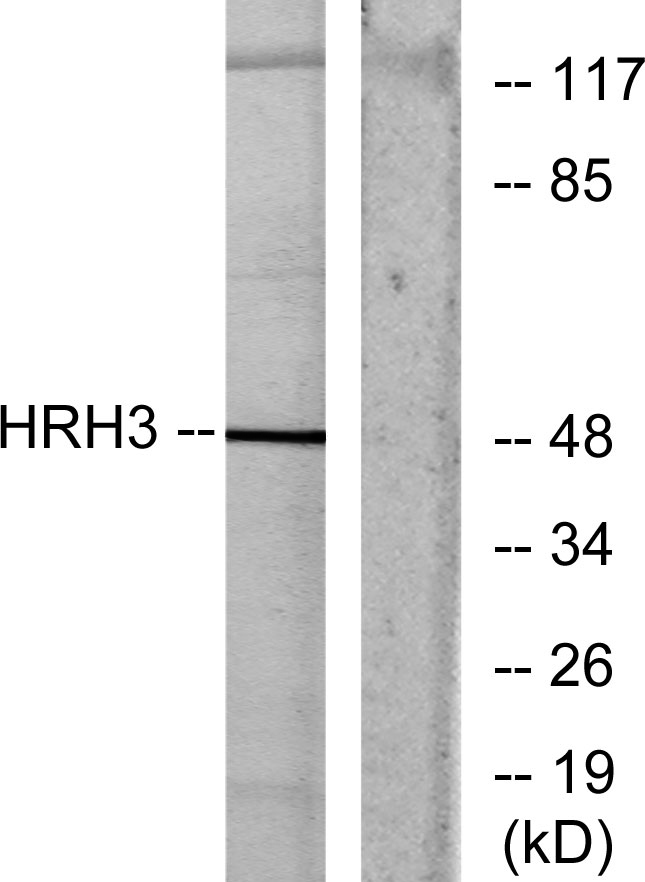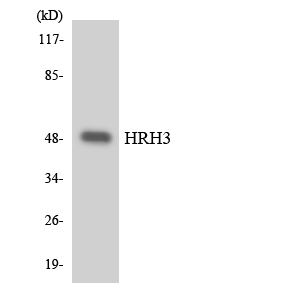Histamine H3 Receptor Polyclonal Antibody
- Catalog No.:YT2142
- Applications:WB;IHC;IF;ELISA
- Reactivity:Human;Mouse;Rat
- Target:
- Histamine H3 Receptor
- Fields:
- >>Neuroactive ligand-receptor interaction
- Gene Name:
- HRH3
- Protein Name:
- Histamine H3 receptor
- Human Gene Id:
- 11255
- Human Swiss Prot No:
- Q9Y5N1
- Mouse Gene Id:
- 99296
- Mouse Swiss Prot No:
- P58406
- Rat Gene Id:
- 85268
- Rat Swiss Prot No:
- Q9QYN8
- Immunogen:
- The antiserum was produced against synthesized peptide derived from human HRH3. AA range:291-340
- Specificity:
- Histamine H3 Receptor Polyclonal Antibody detects endogenous levels of Histamine H3 Receptor protein.
- Formulation:
- Liquid in PBS containing 50% glycerol, 0.5% BSA and 0.02% sodium azide.
- Source:
- Polyclonal, Rabbit,IgG
- Dilution:
- WB 1:500 - 1:2000. IHC 1:100 - 1:300. IF 1:200 - 1:1000. ELISA: 1:5000. Not yet tested in other applications.
- Purification:
- The antibody was affinity-purified from rabbit antiserum by affinity-chromatography using epitope-specific immunogen.
- Concentration:
- 1 mg/ml
- Storage Stability:
- -15°C to -25°C/1 year(Do not lower than -25°C)
- Other Name:
- HRH3;GPCR97;Histamine H3 receptor;H3R;HH3R;G-protein coupled receptor 97
- Observed Band(KD):
- 49kD
- Background:
- Histamine is a ubiquitous messenger molecule released from mast cells, enterochromaffin-like cells, and neurons. Its various actions are mediated by histamine receptors H1, H2, H3 and H4. This gene encodes one of the histamine receptors (H3) which belongs to the family 1 of G protein-coupled receptors. It is an integral membrane protein and can regulate neurotransmitter release. This receptor can also increase voltage-dependent calcium current in smooth muscles and innervates the blood vessels and the heart in cardiovascular system. [provided by RefSeq, Jul 2008],
- Function:
- alternative products:Additional isoforms seem to exist,function:The H3 subclass of histamine receptors could mediate the histamine signals in CNS and peripheral nervous system. Signals through the inhibition of adenylate cyclase and displays high constitutive activity (spontaneous activity in the absence of agonist). Agonist stimulation of isoform 3 niether modified adenylate cyclase activity nor induced intracellular calcium mobilization.,miscellaneous:Does not bind to cimetidine and tripolidine. Shows modest affinity for thioperamide, imetit, N-alpha-methylhistamine and R(-)-alpha-methylhistamine. Isoform 4 is unable to bind to iodoproxyfan while isoforms 1 and 3 bind it with high affinity.,similarity:Belongs to the G-protein coupled receptor 1 family.,tissue specificity:Expressed predominantly in the CNS, with the greatest expression in the thalamus and caudate nucleus. The various is
- Subcellular Location:
- Cell membrane; Multi-pass membrane protein.
- Expression:
- Expressed predominantly in the CNS, with the greatest expression in the thalamus and caudate nucleus. The various isoforms are mainly coexpressed in brain, but their relative expression level varies in a region-specific manner. Isoform 3 and isoform 7 are highly expressed in the thalamus, caudate nucleus and cerebellum while isoform 5 and isoform 6 show a poor expression. Isoform 5 and isoform 6 show a high expression in the amygdala, substantia nigra, cerebral cortex and hypothalamus. Isoform 7 is not found in hypothalamus or substantia nigra.
- June 19-2018
- WESTERN IMMUNOBLOTTING PROTOCOL
- June 19-2018
- IMMUNOHISTOCHEMISTRY-PARAFFIN PROTOCOL
- June 19-2018
- IMMUNOFLUORESCENCE PROTOCOL
- September 08-2020
- FLOW-CYTOMEYRT-PROTOCOL
- May 20-2022
- Cell-Based ELISA│解您多样本WB检测之困扰
- July 13-2018
- CELL-BASED-ELISA-PROTOCOL-FOR-ACETYL-PROTEIN
- July 13-2018
- CELL-BASED-ELISA-PROTOCOL-FOR-PHOSPHO-PROTEIN
- July 13-2018
- Antibody-FAQs
- Products Images

- Western Blot analysis of COLO205 cells using Histamine H3 Receptor Polyclonal Antibody

- Western blot analysis of lysates from COLO205 cells, using HRH3 Antibody. The lane on the right is blocked with the synthesized peptide.

- Western blot analysis of the lysates from RAW264.7cells using HRH3 antibody.



